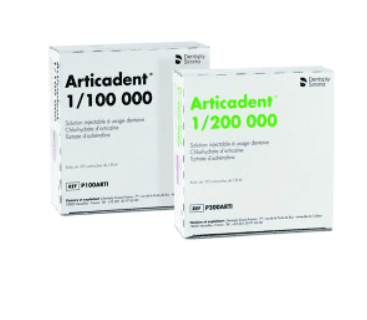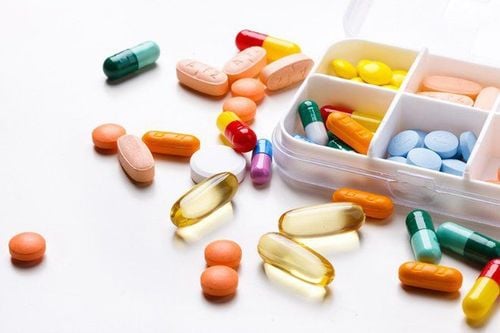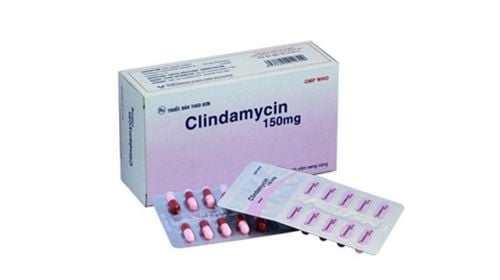This is an automatically translated article.
Articaine drug is made in the form of an injection, with the main ingredient being Articaine. The drug is used in anesthesia for dental procedures.
1. The use of local anesthetic Articaine
Articaine local anesthetic with the main ingredient is Articaine. This is an intermediate acting local anesthetic (amide type). Articaine works well in people with sensory overstimulation. In addition, Articaine was also more effective than lidocaine in regional anesthesia. When used for penetrating injection, Articaine has an anesthetic effect 3.81 times higher than other anesthetics.
Indications for the use of Articaine: Anesthesia in dental procedures.
Contraindications to the use of Articaine:
People with hypersensitivity to amide-type local anesthetics or sodium metabisulfite; People with idiopathic or congenital methemoglobinemia; People with hemoglobinopathy (sickle cell disease).
2. How to use and dose of Articaine
Usage: Injection route.
Dosage: Determine dose based on type, level of procedure performed, depth of anesthesia, degree of muscle relaxation and patient condition. The smallest effective dose of Articaine should be used. For pediatric patients, the dose should be determined based on age, weight, physical condition, type and extent of surgery.
Specific dosages are as follows:
Children: For children 4 years of age and older, use a lower dose than recommended in healthy adults: Simple surgery: Use a maximum dose of 5.65mg/kg; Complicated surgery: Use a dose of 0.37-7.48mg/kg. Adults: The usual dosage range is 20 - 204mg. The maximum dose of Articaine in children and adults: 7mg/kg (0.17 mL/kg).
Dosage in other subjects:
Patients with liver failure: Reduce dose; Elderly patients: Reduce dose in people over 65 years of age; Reduce dose in cardiovascular, debilitated and acutely ill patients.
3. Articaine side effects
When using Articaine, patients may experience some side effects such as: Pain, headache, swollen gums, facial swelling, infection. Patients should immediately report these side effects to their doctor for immediate intervention.
4. Be careful when using Articaine
Some notes for patients to remember before and while using Articaine:
Before taking Articaine, doctors should warn patients about the possibility of temporary loss of sensation and muscle function after injecting invasive drugs. Articaine contains epinephrine that can cause tissue necrosis or systemic toxicity. Therefore, consideration should be given to the precautions associated with the use of epinephrine ; Accidentally injecting Articaine into a blood vessel can cause convulsions, confusion, respiratory failure, coma, or respiratory arrest. Therefore, this risk should be taken into account and the drug should only be used by physicians with sufficient knowledge in the diagnosis and management of toxicity. At the same time, resuscitation equipment and medicine should be prepared; Articaine injection contains sodium metabisulfite, which may cause allergic reactions (including anaphylaxis and life-threatening asthma attacks) in some people who are sensitive to this ingredient; Articaine local anesthetic may cause CNS side effects such as dizziness, dizziness, disorientation, anxiety, restlessness, tinnitus, excitement, tremor, blurred vision, drowsiness, depression ,... Should monitor the patient's level of alertness after each injection; Articaine can cause cardiovascular side effects such as decreased myocardial contractility, impaired cardiac conduction and peripheral vasodilation. Patients may have atrioventricular block, ventricular arrhythmias, and cardiac arrest. The patient's cardiovascular and respiratory vital signs should be monitored after each injection; Use Articaine with caution in people with arrhythmia, heart block or other cardiovascular disease; Articaine hydrochloride injection contains epinephrine, so it may cause an exaggerated vasoconstrictor reaction in patients with hypertension or peripheral vascular disease, at risk of ischemic injury or necrosis; Articaine should be used with caution in pregnant women and nursing mothers, only if prescribed by a doctor (after considering the correlation between benefits and risk factors); Currently, there is no assessment of the safety and effectiveness of Articaine in children under 4 years old, so it should not be used for this subject; Articaine should be used with caution in patients with severe hepatic impairment.
5. Articaine drug interactions
Some of the drug interactions of Articaine include:
Approximately 5 - 10% of Articaine is metabolised by CYP enzymes; Concomitant use of Articaine and general anesthetics may cause cardiac arrhythmias; Concomitant use of Articaine with tricyclic antidepressants or MAO inhibitors can cause severe and prolonged hypertension (due to the epinephrine component); Concomitant use of Articaine with Butyrophenones and Phenothiazines may reduce or reverse the effects of epinephrine. Before taking Articaine, patients should inform their doctor about any drugs, supplements they are using or diseases they are suffering from (including cardiovascular disease). This helps reduce the risk of drug interactions or dangerous side effects, improving the effectiveness of successful treatment.
Follow Vinmec International General Hospital website to get more health, nutrition and beauty information to protect the health of yourself and your loved ones in your family.
Please dial HOTLINE for more information or register for an appointment HERE. Download MyVinmec app to make appointments faster and to manage your bookings easily.













